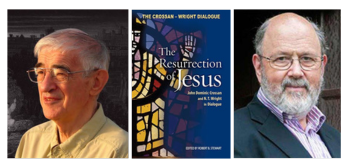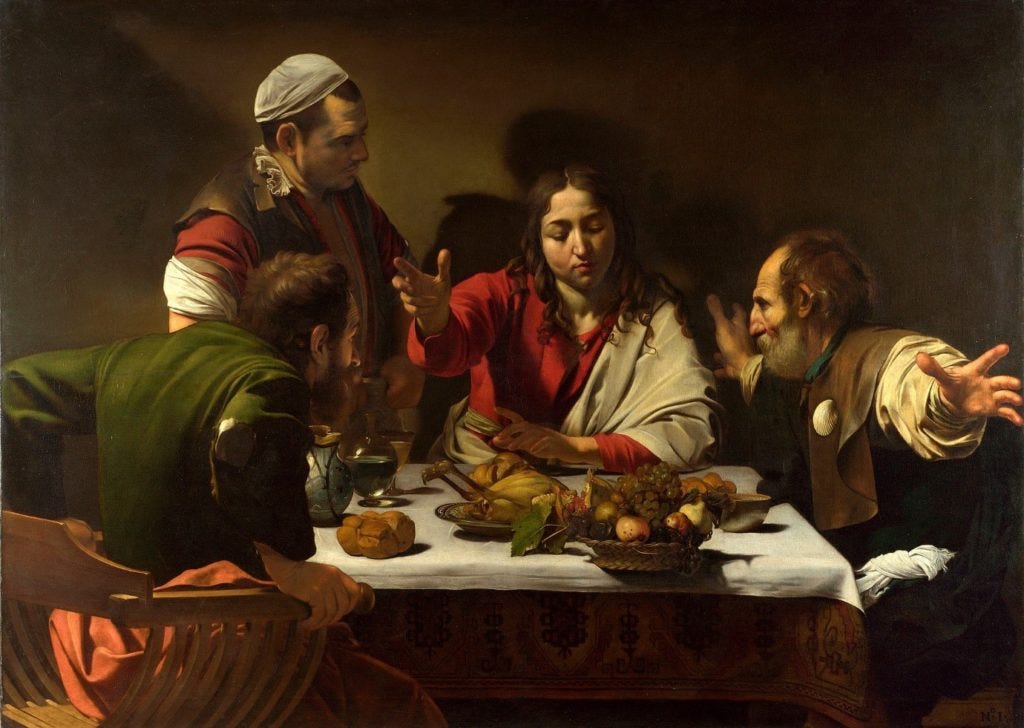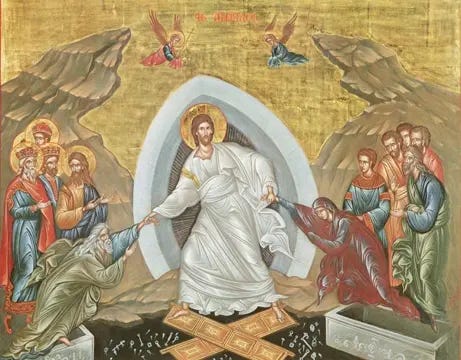In Part I, we explored how resurrection is not a divine transaction to fix Eden’s rupture, but a revelation—a pattern of life breaking through death, already visible in creation and scripture. Now we return to one essential thread: what do we even mean when we talk about resurrection? More specifically: what do we mean when we talk about a body being raised?
This is where the dialogue between N. T. Wright and John Dominic Crossan becomes illuminating. Both believe resurrection matters. Both agree it’s not mere resuscitation. But they diverge on one pivotal point: how central is Jesus’ body to the meaning of Easter?
For Crossan, resurrection is a theological and communal awakening—a people rising in the name of the crucified. The story transforms because it is proclaimed, not because a corpse walked out of a tomb. For Wright, that proclamation only carries weight because something happened in history: the tomb was empty, and Jesus’ body was transformed.
And that, it turns out, is no simple matter. Because when the early church spoke of the “body,” they didn’t mean what most of us hear today. To grasp what resurrection meant to Paul—or to those who shaped the creeds—we must recover an ancient grammar of embodiment. One in which a person might truly have a body, even without possessing flesh. Huh?
Flesh and Body
In 1 Corinthians 15, Paul describes the resurrection body using a phrase that resists easy explanation: sōma pneumatikon. Across translations—from the King James of 1611 to the NRSV, NIV, ESV, and even The Message—it’s rendered almost uniformly as “a spiritual body.” But what does that even mean?
To modern ears—shaped by Plato, Descartes, and centuries of dualism—it sounds like a contradiction in terms. Is it body or spirit? Pick one. But Paul isn’t playing by our binaries. He’s not describing a ghost, nor is he pointing to a flesh-and-blood body brought back to life like Lazarus. In Paul’s world, flesh (sarx) and body (sōma) were not synonyms.
Sarx referred to the perishable stuff of life—mortal, corruptible, prone to injury and decay. Sōma, by contrast, referred to the self as embodied presence—identity, agency, personhood. Paul’s radical claim is this: what goes into the tomb is flesh; what is raised is a spiritual body, animated by the Spirit of God.
Yes, this sounds odd to our ears. But modernity has redrawn the lines in ways the ancients wouldn’t recognize. One of the few things modern Christians might agree on is that the soul is immaterial—weightless, unmeasurable, a metaphysical abstraction. But this wasn’t the case for the ancients. In Paul’s world, the spirit had mass. The word pneuma—translated as “spirit”—also means wind or breath, something invisible yet physical. The soul wasn’t seen as ethereal or vaporous. It was substantial. Tangible. This helps explain Paul’s sōma pneumatikon not as a ghostly wisp but as a body enlivened by divine breath—a presence transfigured, not discarded.
Our assumptions about “body” as material and “spirit” as immaterial owe more to Descartes and Plato than to Paul or Jesus. Resurrection, for the earliest Christians, was not about leaving the body behind—it was about the body being made new.
And Paul couldn’t be clearer on this point writing, “Flesh and blood cannot inherit the kingdom of God, nor does the perishable inherit the imperishable” (1 Corinthians 15:50). In other words: something must change. The resurrection is not a return to what was, but the unveiling of what’s next.
When it comes to the resurrection of the body, confusion runs deep. Generations of theologians—Karl Rahner, Edward Schillebeeckx, Jürgen Moltmann, David Bentley Hart—have been accused of denying it altogether. But often, the accusation is rooted not in disbelief, but in a deeper fidelity to what body meant in the first place.
Take David Bentley Hart. In response to critics who accused him of spiritualizing the resurrection, Hart doesn’t flinch. In a public lecture, he defends the ancient and technical understanding of sōma, noting bluntly: “There is absolutely no competent New Testament scholar who does not know this to be the case.”
So when you recite the Apostles’ Creed (I believe in the resurrection of the body, and the life everlasting) what you’re affirming may not be what you think you’re affirming. The creed doesn’t describe a corpse reassembled or a soul floating upward. It names something stranger, subtler, and more glorious: the transformation of the self into something new, something Spirit-filled, something more real than flesh and blood could ever carry.
History of the Body (Sōma)
When the early church confessed “the resurrection of the body,” it wasn’t making a crude claim about reanimated flesh. It was drawing a line against Gnostic and Platonic philosophies that treated the body as a prison for the soul—something to be discarded, escaped, or transcended. In a world where many spiritual movements sought salvation by fleeing the physical, Christians made the audacious claim that creation itself—including the body—was good, beautiful, and though corruptible, destined for renewal.
This was never about reviving corpses. It was about affirming that God’s redemption includes the whole person: identity, community, and the material world.
To say “resurrection of the body” was to reject the idea that salvation is the soul’s escape. It was to proclaim that the God who raised Jesus would also redeem creation—not by negating it, but by transfiguring it. Early Church thinkers like Gregory of Nyssa didn’t imagine flesh simply stitched back together. They asked deeper questions: “What is resurrection to me, if instead of me someone else returns to life? How would I recognize myself, seeing in myself that which is not myself? I would not truly be myself if I were not in all respects the same as myself.” (On the Soul and the Resurrection, 10).
Nyssa’s insight is key: resurrection isn’t about matter alone, but continuity of personhood—sōma as identity, not anatomy.
When the Creed speaks of “the resurrection of the body,” it echoes a deep scriptural witness: that creation—our embodied, earthy existence—is not a mistake to be escaped, but a gift to be renewed. This is a thread we have lost, corrupted, or simply forgotten. Just as popular Christianity has turned “heaven” into a story of escape—as if salvation means leaving this world behind—we have distorted resurrection into a kind of cosmic evacuation. But Genesis opens with a different vision: “In the beginning God created the heavens and the earth” (Gen. 1:1). In the ancient world, “heavens and earth” were not divided into spiritual and material realms, but together named the whole of creation—both realms created, both called good.
The Second Coming, too, has been misread through this lens of escape, as if the goal were abandonment of a doomed planet. But Jesus’ prayer teaches otherwise: “on earth as it is in heaven.” The transformation of this world—not its destruction—is the point. Resurrection is not a ticket to somewhere else, but the unveiling of what this world is meant to become when flooded with the fullness of divine life. To say “I believe in the resurrection of the body” is to believe that this creation—these bodies—are destined for renewal. Scarred, yes, but transfigured.
And here’s the surprising thing: as foreign as body without flesh might sound, modern thought offers striking parallels to this ancient distinction between sarx (flesh) and sōma (body).
German phenomenologists, for example, distinguish between two ways of being embodied. Leib refers to the lived body—the body as felt from within: subjective, relational, experienced. Körper, by contrast, is the objective body—the measurable, anatomical thing that others observe from without.
Even in neuroscience and consciousness studies, this mystery finds echoes. Researchers now distinguish between the body as biological organism and the body as the locus of memory, identity, agency, desire, and relational presence. What’s more, a growing body of research challenges the old assumption that the mind simply emerges from the brain—as if consciousness were just the flickering of circuits. The categories of brain and mind, once used interchangeably, are now understood to be irreducible to each other. Again and again, we find that mental life—thoughts, emotions, awareness—cannot be collapsed into tissue alone.
In this light, the body is not just a bundle of organs or a biological shell—it is a lived space of meaning we call a person. You are more than the sum of your parts; more than what can be scanned, weighed, injured, or buried.
So when scholars like Crossan and Wright debate the mechanics of the resurrected body, it’s not just a debate about ancient metaphysics. It reveals a deeper gap between what we mean by body today and what Scripture meant. And, perhaps more surprisingly, it also opens up a strange kinship between ancient theology and modern science—both groping toward a mystery: that the body is more than flesh, and the self more than matter.
So, Who Is Right?
Plato imagined the soul slipping free from the body like steam from a kettle—liberated, weightless, eternal. Paul spoke instead of a spiritual body—not the absence of a body, but its transformation. Ancient Jewish texts sometimes gave the soul weight and mass; modern science, for its part, offers no definitive verdict. So who wins the day—Crossan or Wright? Do we leave the body behind, or rise with one transfigured?
Maybe the question is less about winners and more about witnesses. There’s a strong case to be made that the Gospels speak of resurrection in two distinct—but overlapping—ways: as something continuous with what came before, and as something radically, bewilderingly new.
In the Synoptic Gospels, resurrection is already a point of public debate. The Sadducees reject it. The Pharisees defend it—as future vindication, grounded in apocalyptic hope. But in John’s Gospel, something shifts. When Martha offers that same distant expectation—“I know he will rise at the last day”—Jesus interrupts her with something unthinkable: “I am the resurrection.” Resurrection becomes not just a future event. It becomes a person. A presence. A rupture in time standing right in front of her.
After the resurrection, the Gospel writers are at pains to do three things: First, to proclaim that the one who had preached resurrection in life now embodies it more fully in death. Second, to insist on continuity between the body of Good Friday and the body of Easter. Jesus tells his disciples he is not a ghost. He invites them to touch his wounds. He eats fish. This is not abstraction. And yet—third—they also go out of their way to describe that body as radically transformed. Not merely resuscitated like Lazarus, but changed in ways that defy categories. Again and again, the risen Christ is unrecognizable to the people who knew him best.
Mary mistakes him for a gardener. Two disciples walk with him for miles on the road to Emmaus and don’t recognize him until he breaks bread—and then he vanishes. Later, on a beach, the disciples share breakfast with him. They suspect who he is, but “none of them dared ask, ‘Who are you?’” (John 21:12). What a strange way to describe being in the presence of your friend.
And yet maybe that’s the point. The Gospel writers weren’t just reporting facts. They were testifying to something they could barely name: the world had cracked open, and what poured in was not a ghost, not a revived corpse, but a life so real it couldn’t be recognized at first glance. A life that bore scars, but refused to be reduced to them.
Not Just One Body, Every
But here is perhaps the most important part of Scripture’s witness to Jesus’ resurrection: the central question is not was it or wasn’t it a body? The more urgent question is: was it only his?
By the time we reach Acts and Paul’s letters, resurrection has become both theological anchor and historical claim. Paul writes that Jesus was “declared to be the Son of God in power by the resurrection from the dead” (Romans 1:4). But it’s never only about Jesus. Resurrection becomes the axis on which everything turns. “If Christ is raised,” Paul proclaims, “you too shall be raised.”
If resurrection is confined to one body in the first century, it can be safely historicized—or skeptically shelved. But even in the first century, it was never meant to be that small. Within their metaphysics and categories, the early Christians were naming something cosmic: a rupture in the order of things, a future breaking into the present, and it had everything to do with them.
Do we need to adopt every ancient cosmological assumption to receive their claim? No. But neither should we assume our modern materialism gets the final word.
If Easter is to mean anything today, it cannot be confined to Jesus’ “spiritual body” alone. It must name something happening now. Not a divine exception, but a divine pattern. A revelation of what reality itself is bent toward. Because if Jesus is the only one ever to be raised—what are we left with? A pariah. A cosmic outlier. A divine anomaly. And in that case, Hitchens was right to ask: So what?
So what if Jesus was raised from the dead—if he’s the only one, the only time? Then resurrection changes nothing. It’s a celestial magic trick. A holy fluke. And the rest of us? We’re left to make peace with the world as it is: where might makes right, where wealth masquerades as blessing, where the vulnerable are disposable, and where the news cycle is a relentless sacrament of fear.
We’re told to accept mass incarceration as justice. Climate collapse as progress.Gun violence as freedom.Corporate greed as virtue. And war—always war—as the price of peace. If resurrection doesn’t confront that, it’s not worth much.
So What If It’s True?
So let me answer Hitchens’s challenge: “So what if it’s true?” If resurrection is just an artifact of the creed—something to be affirmed, recited, or defended—then his question exposes its impotence. What difference does it make? Because if resurrection is merely a statement we assert to be true, disconnected from how we live, it becomes a hollow and cynical claim.
But what if resurrection is not just a line in the Creed, but a pattern we’re meant to inhabit?
This is why the early church grew—not because they said Jesus was raised, but because they were. It wasn’t just his empty tomb—it was theirs. Resurrection wasn’t a tenet, or an article of faith, or a theological footnote. It was a way of seeing the world through Easter-tinted lenses. A way of living.
The early Christians didn’t draw Caesar’s attention because they proclaimed resurrection—others had done that. They drew attention because they embodied it, as a defiant alternative to empire’s values.
I think the best theologians today are less concerned with metaphysical details about Jesus’ post-resurrection body and more concerned with the connective tissue between Easter and daily life.
James K. A. Smith reminds us that faith begins not with belief, but with desire—that we are shaped by what we love, not what we think. Kierkegaard calls faith a risk, a leap, something lived rather than concluded. Bonhoeffer insists faith must be embodied—that to believe in resurrection is to live as if death has already lost. Paul Tillich names faith our ultimate concern—what we orient our entire being around. Rowan Williams writes of faith not as certainty, but as fidelity—staying with the story when it’s hardest to stay. Each of them is asking the same question in their own way: If resurrection is true… how then shall we live?
Honestly, I don’t much care whether you believe in the resurrection the way Crossan does or the way Wright does—so long as you can begin to see the world through Easter-tinted glasses. That is, with eyes trained to spot new life breaking through in the midst of incalculable suffering, beauty in the wreckage, hope in the headlines.
If resurrection is to mean anything now, it cannot remain a vestige of doctrine or a concept to be affirmed in the creed.
Because if resurrection is true, then the violence of empire is not the end of the story.
If resurrection is true, then beauty can rise from wreckage.
If resurrection is true, then love really is stronger than fear.
If resurrection is true, then even under fascism, totalitarianism, or tyranny—ancient or modern—we endure, not through domination, but through a resistance born of love.
And, to adapt the late great Walter Brueggemann - More than any other community, the Church has the power to tell the truth in a culture addicted to illusion, to mourn in a world that teaches denial, and to live resurrection in a society bent on death.






